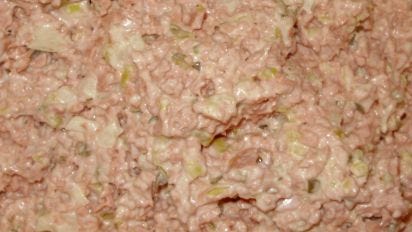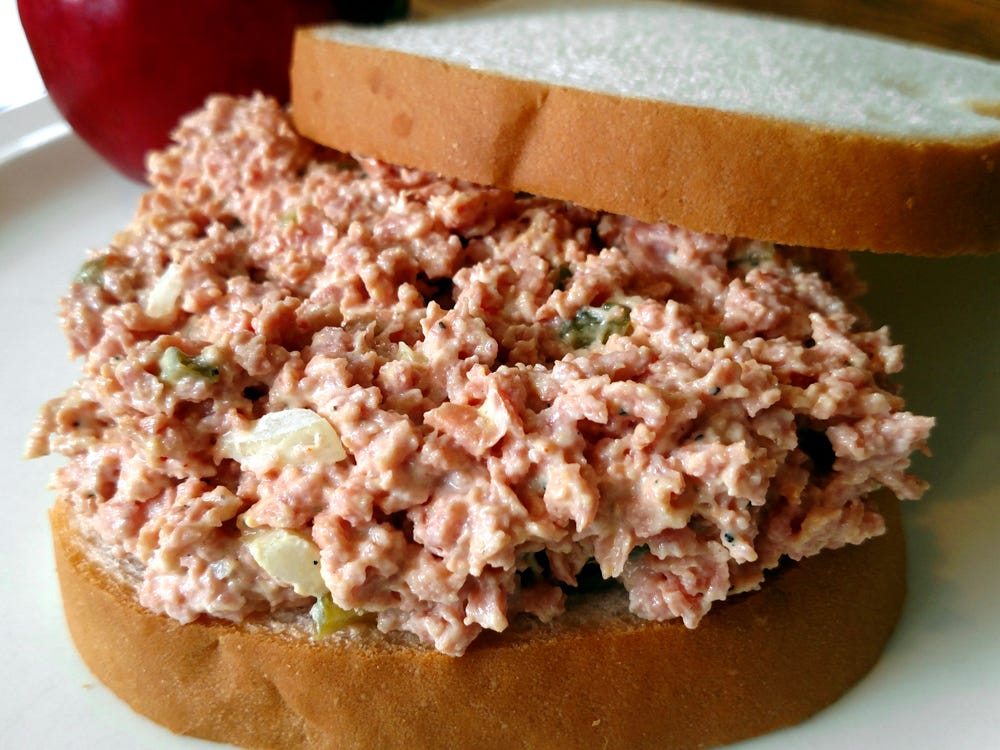Notable Sandwich #6: Dear God, I Have to Write About a Bologna Salad Sandwich
Turn and taste the strange...
Welcome to the latest installment of Notable Sandwiches, the series in which I faithfully chronicle the bizarre and twisted document that is Wikipedia’s List of Notable Sandwiches, in alphabetical order.
I’ve rambled before in this publication about the restraint and pleasure of writing within fixed guidelines—the way that following a preset model, such as the List of Sandwiches, can paradoxically provide great freedom. I’ve gotten to noodle on the page about New York sandwich culture, Jewish history, the scourge that was early-twentieth-century home economics, et cetera. But this week has me seriously doubting my choices for the first time. For I am now confronted with the challenge of writing about the bologna salad sandwich. And my very heart quivers.
I have nothing against bologna itself—it’s a humble and utilitarian cured meat product descended from the more illustrious Italian mortadella, economical, filling and perhaps uniquely suited to the prosaic confines of two slices of white bread. It’s the salad that gets me. The presence of the bologna salad sandwich on The List is something of an enigma: it’s an orphan, with no associated article (either for the salad or the sandwich). It’s listed between “Baked Bean Sandwich” and “Banh Mi,” which suggests a vestigial “baloney” designation (rather than “bologna”). It was added in 2019 by a user named KoolerTheFirst whose primary passion seems to be Nintendo games. With, apparently, a hidden affinity for hideous sandwiches.
This week, I’ve been looking through a lot of recipes for bologna salad, including glowing encomiums to its presence at picnics, hagiographies of specific delis that produce excellent mixtures, and memoir-style food blogs that bathe the bologna salad sandwich in a glow of nostalgia. And I get it: my childhood was full of food that may be unappetizing to others—kishke, greenish mini hot dogs in steam trays at my synagogue’s post-services repast, the ever-controversial gefilte fish. You can’t choose your madeleine (the cookie that sends Marcel Proust’s untitled Narrator into an involuntary convulsion of childhood memory in Swann’s Way), and taste is one of the most efficient routes to unlocking treasured moments from our pasts. All that being said, my cursory descent into bologna-salad studies leaves me with one inescapable conclusion:
Bologna salad looks like dog barf.
When piled up for customers at a deli, bologna salad looks even worse, somehow. It looks like the “pink slime” for which McDonalds was reviled in a mid-2010s consumer panic.
Other names for bologna salad are evocative of its appearance: funeral salad, monkey meat (yes, really), and “PM salad” in Pennsylvania (named for “pickles and meat,” supposedly, but I think it means it’s best eaten in the dark). The dish’s origins are difficult to trace, but one helpful history-minded food blogger notes that it may be a descendant of German Fleischsalat (meat salad), a food that, among other uses, was served to prisoners of war during World War II, to give them strength for enforced strip-mining during a wartime meat shortage.
Outside the confines of German prison camps, bologna salad is apparently happily served on American tables across the land. In most recipes, it’s a mix of chopped or ground bologna, mayonnaise or Miracle Whip, hard-boiled eggs and sweet pickle relish, sometimes with onions added. It’s often prefaced with the words “Old-Fashioned,” with notes that the recipe has been in the family for decades, or, in one case, handed down since a “Teen Club Luncheon back in Iowa in the 50's.”
The Sword and the Sandwich is a newsletter about serious extremism and equally serious sandwiches. Please consider supporting this work with a paid subscription:
The earliest bologna salad recipe I could find dates from 1901, from Recherché Side Dishes: For Breakfast, Luncheon, Dinner and Supper Comprising the Newest Hors D'oeuvre, Savouries, Sandwiches & Salads, Oriental Dishes, Etc, by Charles Senn, which includes the hard-boiled egg but adds beets and “tartare sauce.” According to Google Ngrams, which tracks phrases across time in tens of millions of books, it seems to have gained a spike of popularity in the ‘70s and a much bigger one in 2012, when it was featured in such books as Terry Miller’s Cooking Bachelor Style: Life Beyond the Freezer Section and Coal Camp Kids: Growing Up in a Coal Camp, by Margie J. Pillman. Given the proliferation of novels and memoirs mentioning bologna salad in the 2010s, it seems like a case of midcentury kids turning their childhoods into prose rather than a sudden resurgence of this recherché side dish.
Much of the recent literature that references bologna salad sandwiches does so in rueful tones, to illustrate the distance between the author and a previous generation, or to evoke poverty. Here are a few samples:
“I had a hard time adjusting to life in jail... The food was slimy, cold, and often unrecognizable. Since when did bologna salad come with green chunks? But like my mom always said, if you're hungry, you'll eat it.”
—Vickie Stringer, Let That Be The Reason, 2009
“‘Bologna salad,’ she announced when we stopped at the meat counter. ‘I make it by mixing chopped bologna, celery, and mayonnaise. It lasts me for days.’ This important woman ate bologna salad sandwiches and admitted it to me?’”
—Marion Duckworth, Naked on God’s Doorstep: A Memoir, 2009
“And the sandwiches she packed in a little foam cooler were made of bologna salad on white bread, which I hate. I ate one anyway because we were still new and I was too polite to tell Justin's mom the truth.”
—Trish Doller, The Devil You Know, 2015
“Jesus stood and pushed back his chair. He came around the table to where I was now standing and put his hands on my shoulders. ‘Diana, this lunch was just as enjoyable as when you used to feed me part of your bologna salad sandwiches. It was never about the food we put in our mouths or wouldn't put in our mouths, rather the words that came out of our hearts through our lips.’”
—Dianne Brown, Sorghum’s Galaxy Gazettes: Sci-Fi Allegory of a Transformed Starwalker, 2019
You get the picture. Bologna salad is gross, but evocatively so. Like so many other dishes—aspics and gelatin salads, Salisbury steak, chicken à la king—what was luxurious in the early twentieth century and mod in the ‘50s through the ‘70s has become old-fashioned survival food, reminiscent of childhood, and sometimes privation. Generations age and change, and children grow up to write their own stories. The bologna salad of 2021 is fundamentally different from the bologna salad of 1901 (or 1971), not in composition, but in cultural place. We have no control over the circumstances in which we’re born, what we are fed when we’re young, where we lived, who we were. The only thing we can control is how we share those memories. You can’t choose your madeleine, but you can choose the words you use to describe it, through the alchemy of mind that lets unappetizing fact evolve into story.









Just looking at the pictures I would guess that the origin of bologna salad was someone who had to bring sandwiches to a picnic for people they hated and thought, "What if I made ham salad sandwiches, but terrible?"
hagiographies of specific delis!! Love it. Is there a history of bologna meat becoming Kosher?